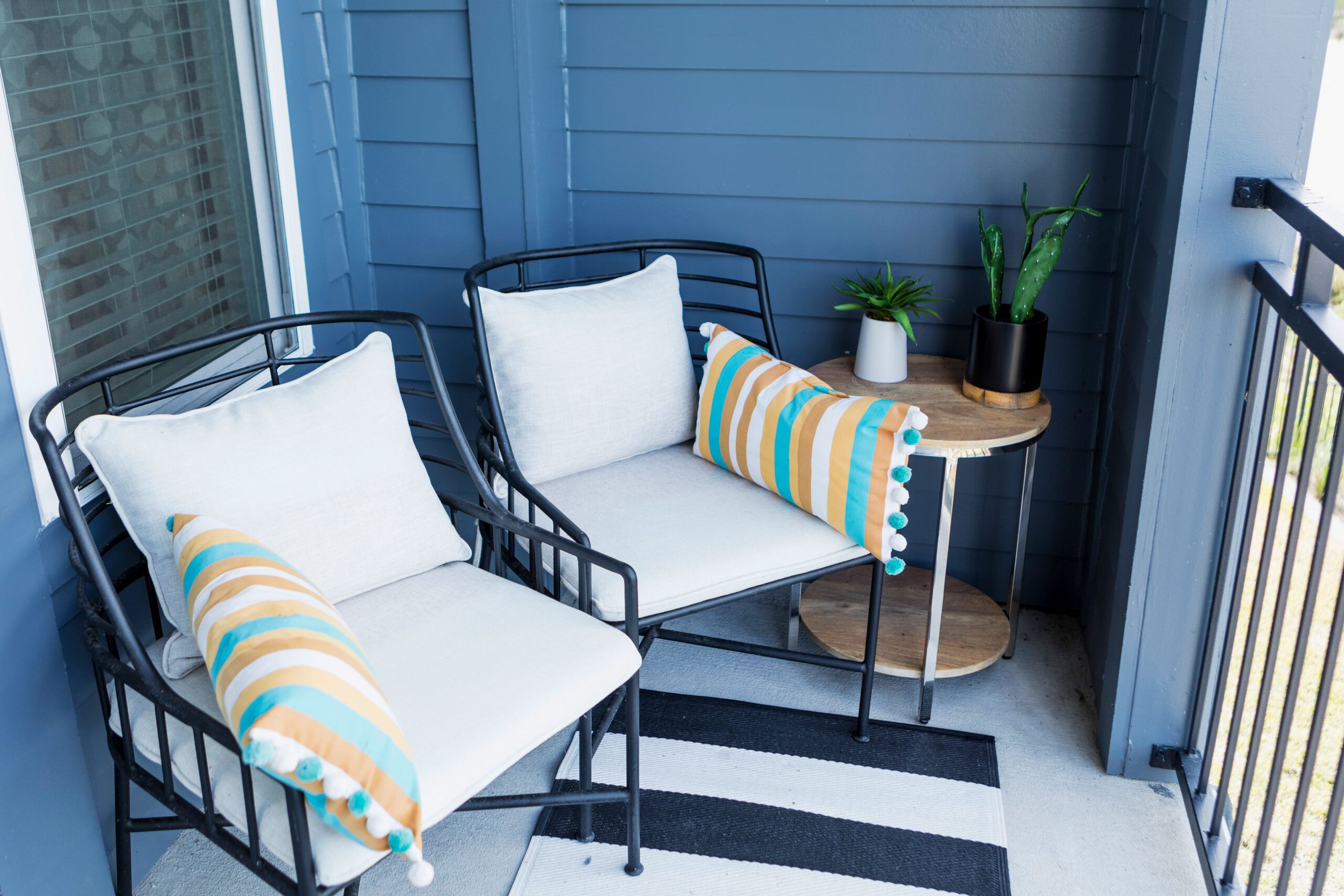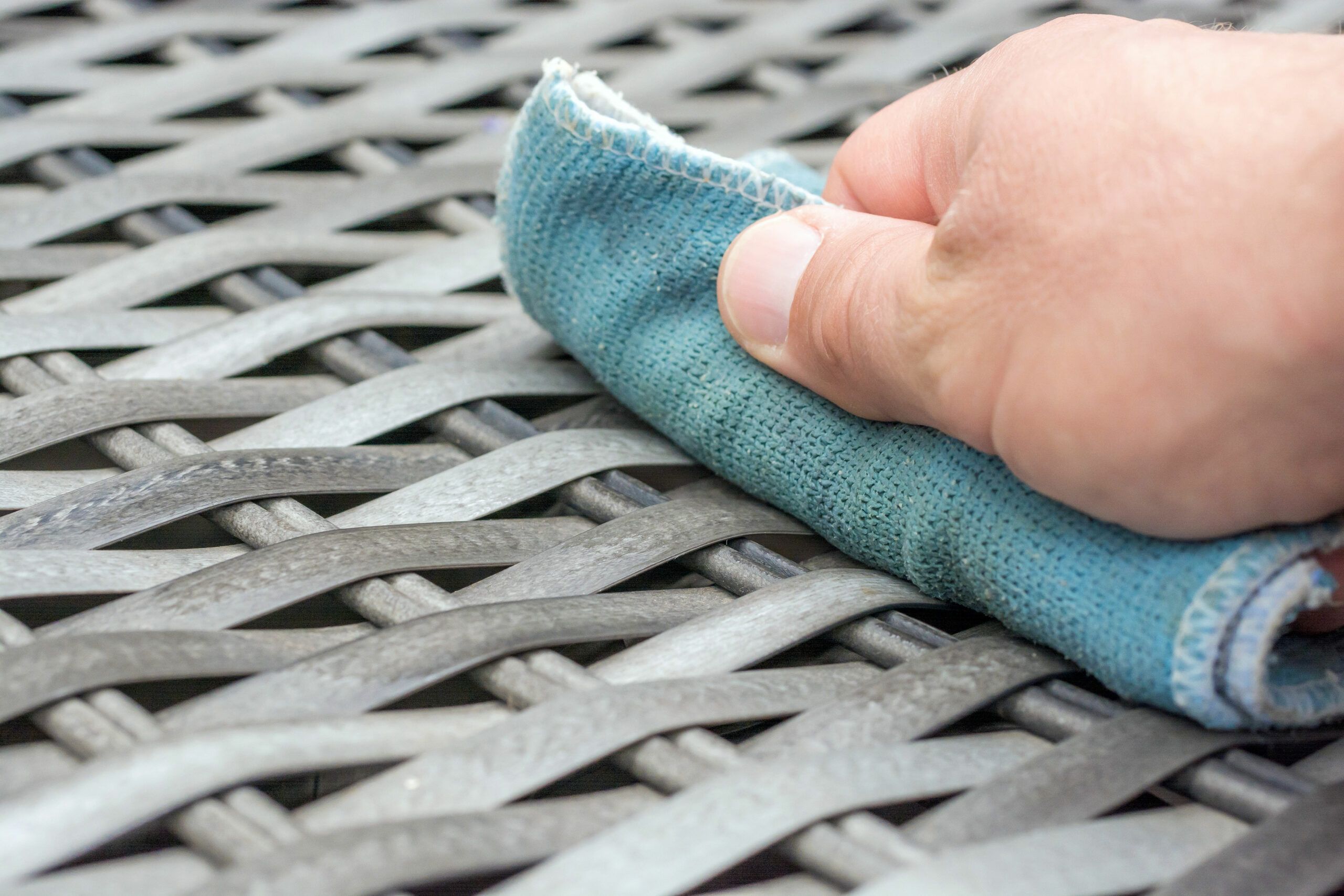Left outdoors in rain and shine, metal deck and patio furniture take a beating. Frames accumulate unsightly nicks, scratches, and rust. Vinyl straps discolor and loosen. Mesh slings rip, and fasteners pop out.
But that doesn’t mean you have to toss the old set and buy a new one. For a fraction of the cost of replacement, you can tackle basic repairs yourself. “This is something homeowners can definitely do,” says Steven Gentino, owner of The Chair Care Co., an outdoor furniture refinisher in New Haven, Connecticut.
“It takes a little muscle and a couple of hours tops.” Gentino’s company is one of many nationwide that can supply the necessary materials, fasteners, and even the touch-up paint; look for “outdoor furniture care” on online or contact the chair manufacturer for a list of authorized repair services. “All you need to do is a little measuring,” Gentino says. “We’ll cut everything to order.”
This guide will walk you through the process of assessing, repairing, and maintaining your patio pieces to keep them looking great for years to come.
Assessing Your Outdoor Furniture’s Condition
Before going about repairs, the first thing you should do is evaluate the current state of your outdoor furniture. This assessment will help you determine the extent of work needed and whether DIY restoration is feasible or if professional help is required.
Common Issues with Metal Furniture
Metal furniture, particularly aluminum and wrought iron pieces, often suffers from cosmetic and structural problems. Look for:
- Scratches and nicks in the paint
- Rust spots, especially on steel frames
- Loose or missing fasteners
- Bent or broken components
Problems with Vinyl and Mesh Components
Vinyl straps and mesh slings are prone to different types of damage:
- Fading or discoloration from sun exposure
- Loosening or stretching of vinyl straps
- Tears or holes in mesh slings
- Mildew or mold growth
Assessing Wood Outdoor Furniture
Wooden outdoor furniture can be susceptible to its own set of problems. Look for:
- Fading or graying from sun exposure
- Splitting or cracking of wood components
- Signs of rot or mildew
- Loose joints or fasteners
Tools and Materials Needed for Restoration of Outdoor Furniture
You likely have most of what you need to clean and repair your furniture somewhere in your house already, aside from any replacement pieces. Here’s what you’ll need to get started.
Cleaning Supplies
- Mild dish soap
- Soft-bristled brush or sponge
- Garden hose or pressure washer
- Vinyl cleaner (for straps and slings)
- All-purpose cleaner
Repair Tools and Hardware
- Sandpaper (100-grit and 220-grit)
- Wire brush
- Touch-up paint or spray paint
- Replacement vinyl straps or mesh sling material
- Plastic pegs or metal clips
- Screwdriver
- Utility knife
- Pipe clamp (for mesh sling replacement)
- Wood stain or sealer (for wooden furniture)
- Epoxy or wood glue
- Replacement wood pieces (if necessary)
Cleaning and Prepping Outdoor Furniture
Proper cleaning is the first step in reviving your outdoor furniture. It removes dirt, grime, and mildew, preparing surfaces for repair and refinishing.
Proper Cleaning Techniques for Different Materials
For most outdoor furniture, start with a simple cleaning solution of mild dish soap and water. Use a soft-bristled brush or sponge to gently scrub the surfaces. Rinse thoroughly with a garden hose or pressure washer on a low setting.
For vinyl straps and mesh slings, use a specialized vinyl cleaner or a mild all-purpose cleaner. Never use abrasives, bleach, or ammonia, all of which strip vinyl of its UV protection.
For wooden furniture, avoid using a pressure washer as it can damage the wood fibers. Instead, use a soft brush and a solution of mild soap and water. Rinse and let dry completely.
Preparing Surfaces for Repair and Refinishing
After cleaning, allow the furniture to dry completely. For aluminum, rough up the surface slightly with 100-grit sandpaper, then smooth with 220-grit paper. There’s no need to prime — just apply an exterior-grade acrylic enamel paint. Use a tiny touch-up brush on nicks and a spray can on bigger scratches.
For wrought iron on tubular steel, use a wire brush and sandpaper to sand any rust spots or chipped paint down to bare metal. Next, brush or spray on a metal primer, then apply an exterior enamel topcoat. (A coat of rust converter such as Rust Reformer stabilizes rust without sanding, but a rough, crusty look will remain.)
For wooden furniture, sand down any rough or splintered areas. If there are cracks, you can fill them with wood filler, sand smooth, and then apply a wood sealer or stain to finish.
Repairing Metal Frames and Components of Your Outdoor Furniture
With the furniture clean and prepped, you can now address any damage to the chair.

Restoring Vinyl Straps and Mesh Slings
Replacing worn-out vinyl straps or torn mesh slings can dramatically improve the look and comfort of your outdoor furniture.
How To Replace Vinyl Straps
Before you begin replacing your vinyl straps, you’ll need to take the following steps:
- Measure the frame: For a single-wrap strap (one with exposed plastic pegs or metal clips), measure across the frame from hole to hole with a cloth tape measure wrapping around the outside of the frame. A double-wrap strap covers the fasteners. Start at one hole, loop the tape measures fully around the frame, then pull to the opposite hole and repeat.
- Order parts: Buy enough straps and pegs to redo the entire piece. (Metal clips can be reused.) The supplier will cut each strap to length and punch a hole for pegs or attach edge clips on both ends.
- Slice through all the old straps with a utility knife and pop the pegs or clips out of the frame with a screwdriver. Touch up or repaint the frame.
Steps for Replacing Vinyl Straps
- Make the straps flexible by soaking them in hot (not boiling) water; never use a hairdryer or heat gun. Attach the strap end by pushing a peg through its hole and into the hole on the back of the frame.
- With the peg seated firmly, wrap the strap all the way around the frame, covering the peg. (For a single wrap, simply go halfway around the frame and pull to the opposite side.)
- Grab the strap near its middle and stretch it to the opposite side of the frame. Hold it tight against this side with one hand; use the other to loosely wrap the strap’s free end around the frame 1½ times.
- Keep tension on the strap as you push a peg through the free end and into its hole. Slide the loop up over the peg with your thumb, then let go of the strap. It will tighten as it cools.
How To Replace Mesh Slings
Before you begin, you’ll need to do some measurements. Find the width by measuring from the center of one rail to the center of the opposite rail at the bolt locations (typically found at the top and bottom of the sling). To find the length, lay a cloth tape measure along the top face of one rail so it follows the rail’s curvature.
Steps for Replacing Mesh Slings
- Slash the old sling down the middle with a utility knife. (A damaged sling cannot be saved.) Remove the end cap on each side rail.
- Slide the two halves of the sling out of their tracks in the chair’s rails. Loosen but don’t remove the bolts that attach the rails to the chair frame, then pop out the spreader bar.
- Remove one rail entirely. Hold the sling with its hem side to the back and slide its nylon rod into the track of the rail that’s still attached to the chair frame.
- Slide the detached rail over the sling’s other nylon rod. Bolt this rail back on the frame. Tighten the loose bolts on the opposite rail to make the sling taut.
- Reinsert the spreader bar. Use a pipe clamp to spread the rails slightly; if need be, bend the bar a bit to make it fit, then hit it with a rubber mallet to restore its shape.
- With a wire cutter, trim each rod flush with the end of the rail. Push the end caps back on the rails.
Refinishing and Repainting Techniques
A fresh coat of paint can work wonders for tired-looking outdoor furniture. Select an exterior-grade paint specifically formulated for the material of your furniture. For metal furniture, choose a paint with rust-inhibiting properties. Look for paints that offer UV protection to prevent fading.
For wooden furniture, choose a wood stain or an exterior paint designed for wood. Make sure the product is suitable for outdoor use and offers protection against the elements.
Application Methods for Best Results
- Ensure the surface is clean, dry, and free of loose paint or rust.
- Apply a primer if needed, especially on bare metal.
- Use spray paint for even coverage on intricate designs.
- For larger flat surfaces, a brush or roller can work well.
- Apply thin, even coats, allowing each to dry completely before adding another.
Repairing and Refinishing Wooden Furniture
Wooden outdoor furniture often requires special care to maintain its appearance and durability.
Addressing Splits, Cracks, and Loose Joints
- Inspect the furniture for any splits or cracks. Fill these with wood filler or epoxy resin designed for outdoor use.
- Tighten any loose joints using wood glue or epoxy. Clamp the joints together until the adhesive cures.
- If some parts are beyond repair, consider replacing those wood pieces altogether.
Staining and Sealing Outdoor Wood Furniture
- Sand the entire surface to remove the old finish and smooth out any rough spots.
- Choose an outdoor wood stain or sealer that provides UV protection and is water-resistant.
- Apply the stain evenly using a brush or cloth, allowing it to penetrate the wood.
- Wipe off excess stain and let it dry fully.
- Apply a clear sealer if the stain does not already include one.
How To Maintain Your Outdoor Furniture
Regular maintenance will help preserve your newly restored furniture and extend its lifespan. With the right care, the plastic components of your furniture should last about 10 years. Here are some simple tips for maintaining your outdoor furniture.

Seasonal Care Tips
- Clean furniture regularly with mild soap and water.
- Touch up paint chips promptly to prevent rust.
- Tighten loose bolts or screws as needed.
- Apply a UV protectant spray to vinyl and mesh components annually.
- Re-stain wooden furniture as necessary to keep the finish looking fresh.
Cleaning Straps and Slings
Both straps and slings are made of vinyl, which suntan oil stains, sunlight fades, and dirt and mildew stick to like magnets. A spritz with a vinyl cleaner such as FeronClean or a mild all-purpose cleaner like Fantastik or Formula 409 and a swipe with a cloth is the best way to remove grime.
Never use abrasives, bleach, or ammonia, all of which strip vinyl of its UV protection. Exposure to pesticides and fertilizers does the same thing. Encourage sunbathers to cover chairs with a towel.
Proper Storage Solutions
The best place for furniture in the winter is a dry spot indoors. If indoor storage isn’t possible, use breathable vinyl covers that don’t touch the ground to allow moisture to escape and prevent mildew and rust. Proper storage is especially important for wooden furniture to prevent the wood from expanding and contracting with weather changes.
DIY vs. Professional Outdoor Furniture Restoration: Making the Right Choice
While many outdoor furniture repairs are DIY-friendly, some situations may call for professional help.
When To Attempt DIY Repairs
Consider DIY restoration for:
- Minor paint touch-ups
- Replacing individual vinyl straps or mesh slings
- Small repairs on wooden furniture
Benefits of Professional Restoration Services
Professional services are beneficial for:
- Extensive rust or structural damage
- Complete repainting with powder coating for metal
- Replacing multiple straps or slings for a perfect fit
- Large-scale woodworking repairs or refinishing
When a painted frame is covered with scratches or caked with rust, it’s probably time for a professional overhaul. Professional refinishers can sandblast and repaint metal furniture with a durable powder-coated finish that can last for well over a decade.

